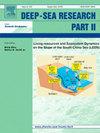Blue carbon in an eastern boundary upwelling zone – A case study in Namibia
IF 3
3区 地球科学
Q2 OCEANOGRAPHY
Deep-sea Research Part Ii-topical Studies in Oceanography
Pub Date : 2025-03-10
DOI:10.1016/j.dsr2.2025.105478
引用次数: 0
Abstract
Blue Carbon (BC) refers to Nature-Based Solutions in marine environments that aim to reduce greenhouse gases through carbon sequestration using natural processes. Much of the BC focus to date has been on tropical coastal habitats, especially salt marshes, mangroves, and seagrass beds, while research in temperate marine environments has lagged. In this paper, we investigate the BC potential in a cold-temperate eastern-boundary upwelling ecosystem, the northern Benguela off Namibia. We identified four areas, where the BC concept can be applied, identify data gaps and areas for future research. 1) Macroalgae play a large role in carbon sequestration globally, although many of the values and specifics remain debated. We recommend research to investigate the ultimate flows, fate and permanence of carbon in Namibian kelp forests, and the development of a high-quality national map of kelp biomass distribution. 2) The northern Benguela has a high abundance of gelatinous plankton, possibly associated with the collapse of the small pelagic fish stocks. Gelatinous plankton play an important role in the global carbon cycle and research into their role in carbon flow and sequestration in the northern Benguela is recommended. 3) Commercial fisheries are amongst the highest producers of carbon globally. We strongly support policies that promote the restoration of Namibian fish stocks, especially sardine and recommend undertaking analyses of the carbon-footprint of Namibian fisheries and their supply chains to identify areas where carbon production could be reduced through improved efficiency, reduced impact on the seabed and optimised transport solutions. 4) Namibia hosts some of the world's most carbon-rich marine sediments along its continental shelf. We recommend conducting a BC natural capital assessment of the environmental and financial value of these sediments and any impacts thereon. These actions could open new markets for Namibian products that prioritise low-carbon foodstuffs. Combined, a more thorough assessment of Namibia's BC ecosystems could contribute substantially to Namibia's nationally determined contributions.
东部边界上升流带中的蓝碳——以纳米比亚为例
蓝碳(Blue Carbon, BC)指的是海洋环境中基于自然的解决方案,旨在通过利用自然过程的碳封存来减少温室气体。迄今为止,不列颠哥伦比亚省的大部分研究重点都集中在热带沿海栖息地,尤其是盐沼、红树林和海草床,而对温带海洋环境的研究则滞后。本文研究了纳米比亚北部Benguela寒温带东缘上升流生态系统的BC势。我们确定了四个可以应用BC概念的领域,确定了数据差距和未来研究的领域。1)大型藻类在全球范围内的碳封存中发挥着重要作用,尽管许多价值和细节仍存在争议。我们建议研究纳米比亚海带森林中碳的最终流动、命运和持久性,并开发高质量的国家海带生物量分布图。2)本格拉北部有大量的胶状浮游生物,这可能与小型远洋鱼类资源的减少有关。胶质浮游生物在全球碳循环中发挥着重要作用,建议研究它们在本格拉北部碳流和固存中的作用。商业渔业是全球最大的碳排放源之一。我们强烈支持促进纳米比亚鱼类资源恢复的政策,特别是沙丁鱼,并建议对纳米比亚渔业及其供应链的碳足迹进行分析,以确定可以通过提高效率、减少对海底的影响和优化运输解决方案来减少碳产量的领域。纳米比亚的大陆架上有一些世界上碳含量最高的海洋沉积物。我们建议对这些沉积物的环境和金融价值及其影响进行不列颠哥伦比亚省自然资本评估。这些行动可以为优先考虑低碳食品的纳米比亚产品开辟新的市场。综合起来,对纳米比亚BC生态系统进行更彻底的评估可以为纳米比亚的国家自主贡献做出重大贡献。
本文章由计算机程序翻译,如有差异,请以英文原文为准。
求助全文
约1分钟内获得全文
求助全文
来源期刊
CiteScore
6.40
自引率
16.70%
发文量
115
审稿时长
3 months
期刊介绍:
Deep-Sea Research Part II: Topical Studies in Oceanography publishes topical issues from the many international and interdisciplinary projects which are undertaken in oceanography. Besides these special issues from projects, the journal publishes collections of papers presented at conferences. The special issues regularly have electronic annexes of non-text material (numerical data, images, images, video, etc.) which are published with the special issues in ScienceDirect. Deep-Sea Research Part II was split off as a separate journal devoted to topical issues in 1993. Its companion journal Deep-Sea Research Part I: Oceanographic Research Papers, publishes the regular research papers in this area.

 求助内容:
求助内容: 应助结果提醒方式:
应助结果提醒方式:


